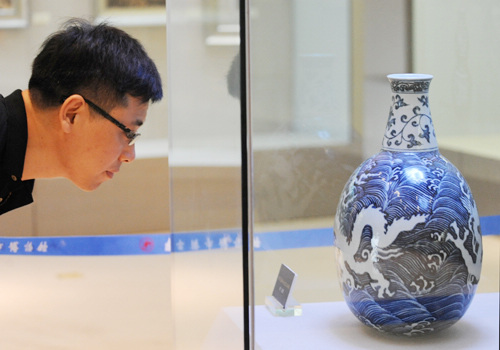 |
|
PRICELESS VASE: The museum of Lianyungang, Jiangsu Province exhibits a blue and white porcelain vase of the Ming Dynasty on July 11. It was sold for 224 million yuan ($35.12 million) at a recent auction (XINHUA) |
Chen Lusheng, Deputy Curator of the National Museum of China, said many active experts on antique authentication are actually fake.
"My experience told me an expert with a grandiose title, such as chairman of a world arts committee, is very likely a fake. Many famous experts appearing on TV programs are not known at all in art circles," Chen said.
Fake experts are also to blame for unrealistically high prices boosted by valuations they gave. It's disastrous if the public always relies on such experts' words instead of their own knowledge and discretion, he said.
"Authentication and valuation is, above all, the key step in the circulation of artworks, which must be subject to strict supervision and regulation," said Li Xiaoshan, professor with the Nanjing University of the Arts.
In developed countries, non-profit galleries play a key role in the market and offer venues for companies to have auctions. But auction companies dominate the Chinese art market. As a result, authentication agencies and auction companies often ally to win maximum economic returns.
Without reliable authentication and effective supervision, the art market has become a grey area where counterfeits grow accordingly as the number of authentication agencies increase. Low cost and high profit of art counterfeiting have lured many into the business.
In addition, fake authentication in the market is often linked to economic crimes, such as money laundering.
"In the long run, this disorder will hinder the sustainable development of China's art market," said Gan.
While reinforcing supervision, the authority also needs to toughen legislative efforts to regulate the market and curb artwork counterfeiting, said Ma.
Relevant stipulations in existing laws and regulations are too ambiguous to practice. The Auction Law of China, clause 61, says "auctioneer do not assume liability if a statement has been made prior to the auction that they cannot guarantee the authentication and quality of the article."
The clause 61 provides a protective umbrella for auction companies selling counterfeit artworks, and makes it difficult for buyers to protect their interests in auction disputes.
"Such a disclaimer helps auctioneers evade obligations and liabilities for fake artworks they sold, which not only impairs the interests of buyers, but also affects the healthy development of the market," said Gan.
"But if the auctioneer has promised the artwork is real before auction, then the buyer can sue the seller when he or she has evidence to prove it's fake," said Hao Jianfeng, a lawyer from Beijing Fada Law Firm.
Other than the clause 61, there are no explicit stipulations addressing issues of artwork authentication, such as a standard procedure, and the qualifications and skills required for artwork authentication agents.
By contrast, the international auction market has set a good example through its 100-odd years of development.
The renowned auction company, Sotheby's, provides clients with a promise that if the auctioned work is found to be a counterfeit in the next five years, the company will revoke the deal and return all the money to the buyer. The other famous auctioneer, Christie's, has similar regulations.
"It is necessary to add amendments to the Auction Law, such as allowing tracking of the transaction history of artworks," said Li.
In the British art market, where buyers practice the tracking right, every party involved in the transaction—including seller, buyer, gallery, auctioneer and dealer—are required to offer necessary information to guarantee the copyright of the artwork.
A truly successful market will never rely on speculation. It's urgent to address problems in the art market and establish a sound market mechanism to enable sustainable development. | 